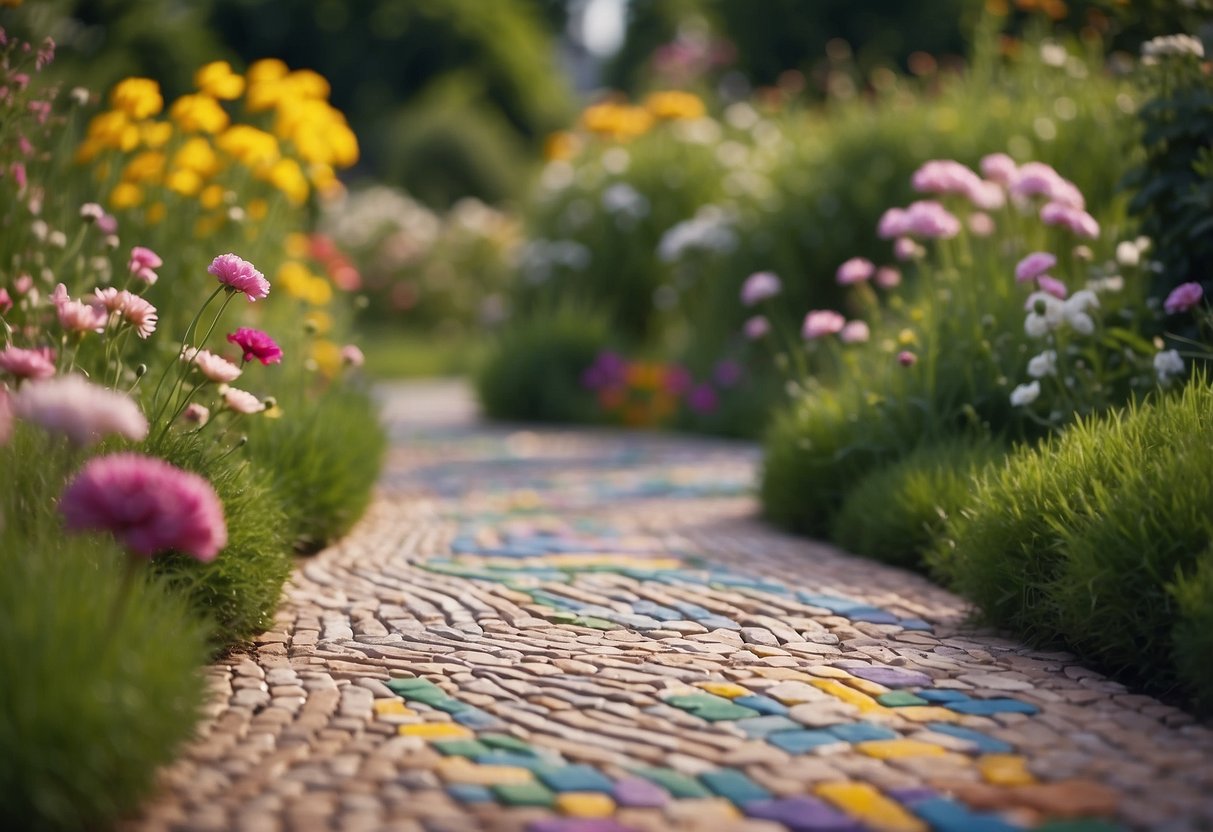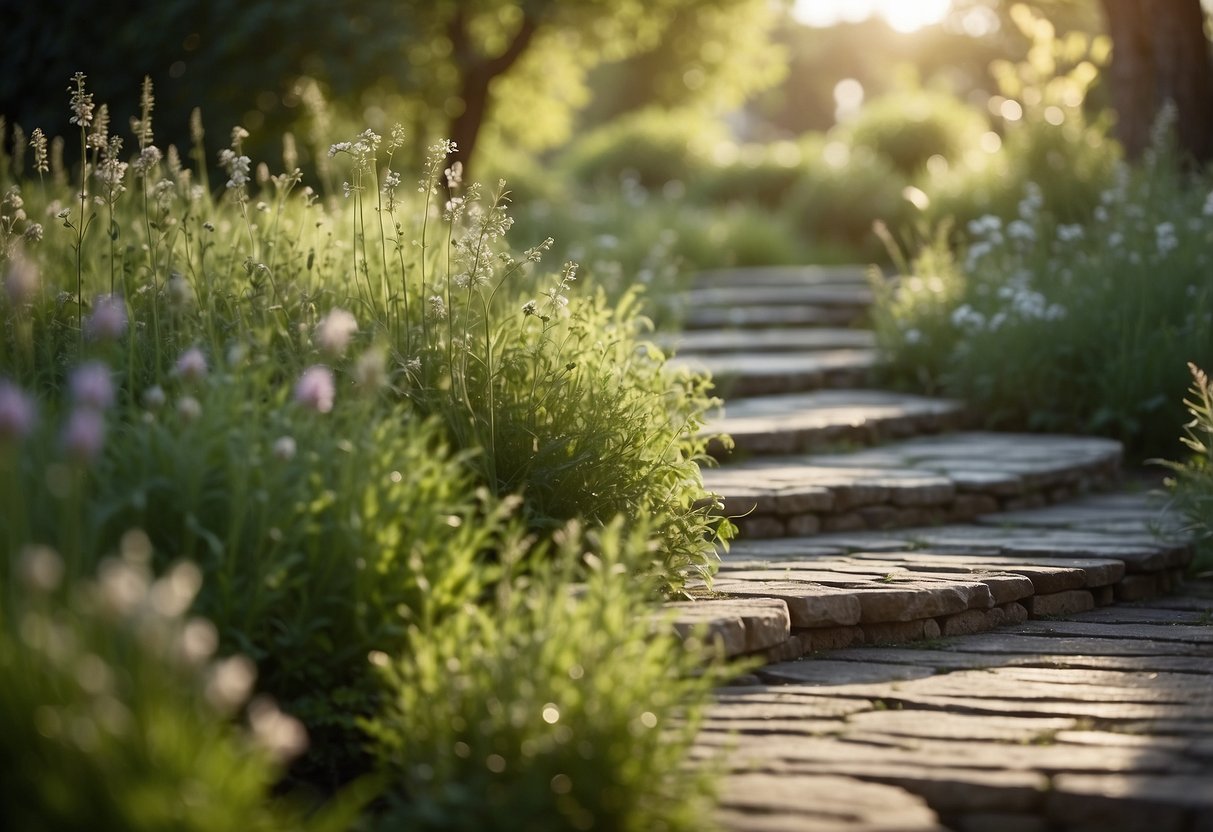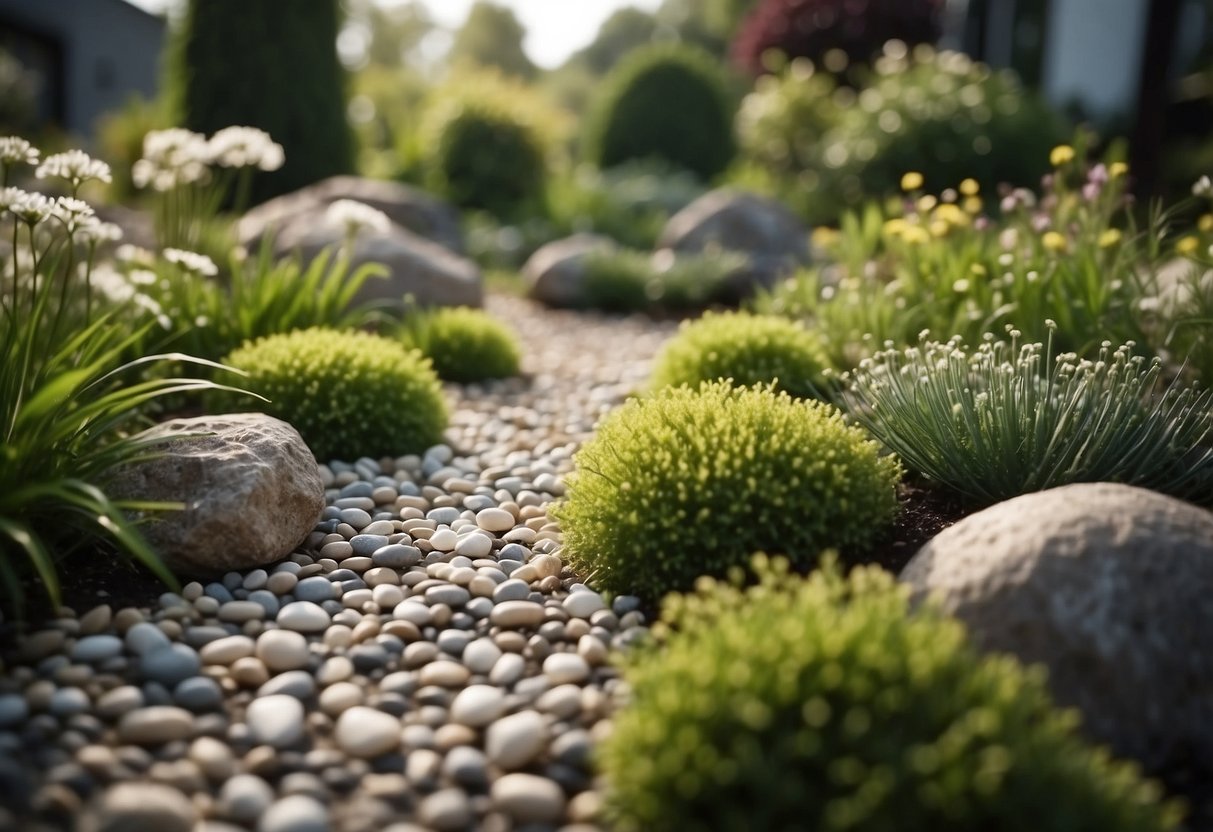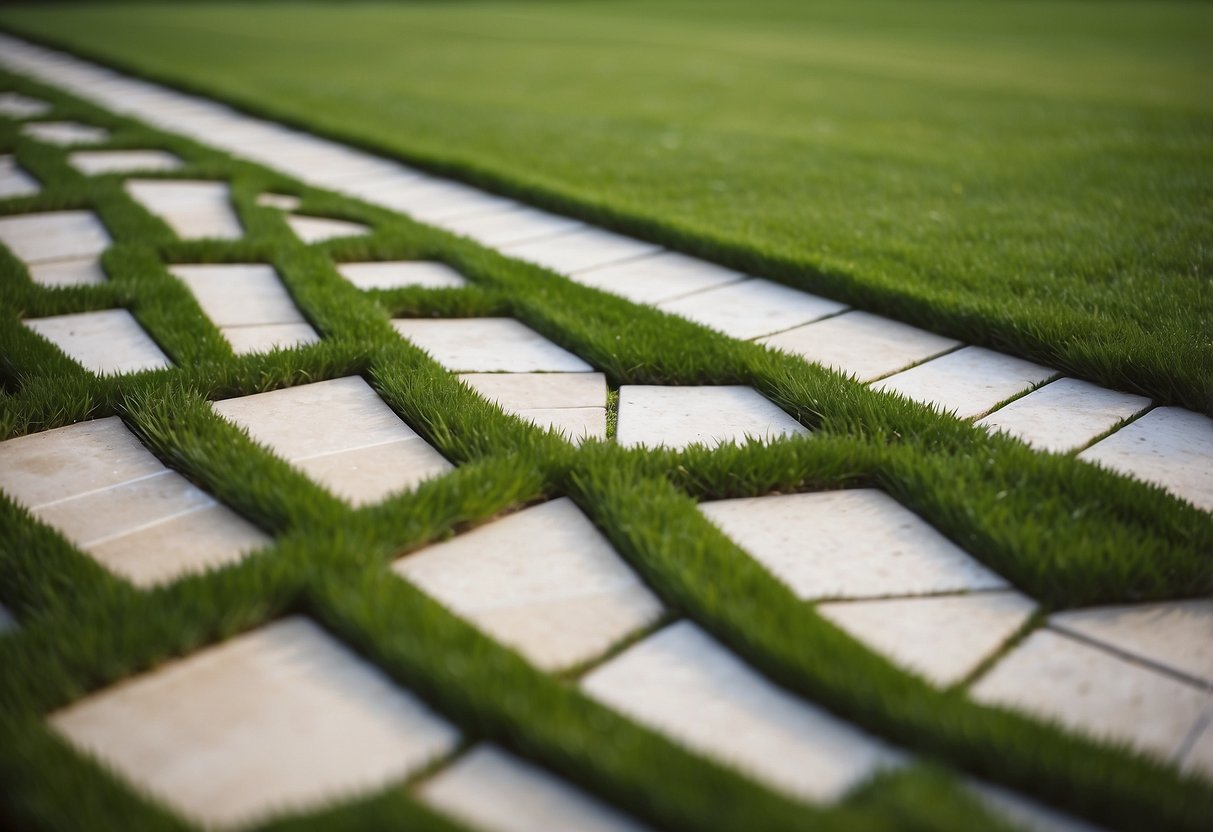Slabs and Grass Garden Ideas: Create Your Perfect Outdoor Oasis
Looking to transform your garden into a peaceful and beautiful retreat? Combining paving slabs with lush grass can create a stunning and functional outdoor space. By mixing different textures and materials, you can design a garden that suits both your aesthetic preferences and practical needs.

Why are slabs and grass a great combination for garden design? This blend allows you to create defined paths, patios, and seating areas while keeping the natural feel of greenery. Whether you have a small backyard or a more extensive garden, these ideas can fit into any space and make it more inviting.
1) Stepping Stone Path

A stepping stone path can transform your garden, combining practicality with charm. You can use a mix of shapes and sizes to create a natural look. Simple square stones nestled into grass offer a classic and inviting feel.
For a creative touch, consider recycled glass bottle stones, which add a sparkling effect. Another idea is to border your stones with smooth pebbles to elevate the path’s appearance.
You can find more ideas for stepping stone paths at Bob Vila and The Spruce.
2) Geometric Concrete Slabs

You can create a modern look in your garden with geometric concrete slabs. These slabs offer clean lines and crisp angles that add a stylish touch to any outdoor space.
Incorporate river stones or grass between the slabs for added contrast. Using lighter and darker shades of concrete can make your design pop.
Geometric patterns ensure a sleek, contemporary feel, making your garden both functional and visually appealing. If you’re looking for inspiration, check out these ideas.
3) Mosaic Tile Footpath

Creating a mosaic tile footpath can add charm and personality to your garden. You can use pebbles, broken tiles, or colorful mosaic pieces to design a unique pathway.
First, mix the mortar or concrete and spread it on a small area of your path. Press the tiles or pebbles into a pattern you like.
Keep repeating these steps until the path is complete. Fill in any gaps between the tiles for a smooth look. This project is a great way to make your garden truly stand out and reflect your personal style.
4) Grass Pavers

Grass pavers offer an attractive and eco-friendly option for your garden paths or driveway. They combine the strength of traditional pavers with the natural beauty of grass.
These pavers cost between $4 to $6 per square foot, which is slightly higher than asphalt or concrete. They usually need replacing every 10 to 15 years.
For a lush, green look, consider filling the spaces between the pavers with grass. Proper installation ensures stability and avoids any shifting over time. Check out more details on grass block pavers at Gardenista.
5) Flagstone Walkway

A flagstone walkway can be a beautiful addition to your garden. The stones come in many finishes and edge styles, from crisp diamond cut to tumbled and hand-hewn slabs.
You can fill the spaces between the stones with grout, grass, or pea gravel. For a natural look, consider adding river pebbles in between the pavers.
Flagstone paths fit well in gardens filled with greenery. They blend naturally and maintain an outdoor feel. Consider weaving your walkway amongst your plants to create a serene, picturesque pathway.
For more ideas, check out these flagstone walkway options.
6) Herb Border Pathway

Creating a herb border pathway in your garden adds both function and beauty. Choose low-growing herbs like thyme, chives, or oregano for the front. Taller herbs like rosemary or lavender can go towards the back.
You’ll enjoy the fragrance as you walk by. The herbs can also serve as a natural pest deterrent. To get started, design your path with the sizes of the herbs in mind.
For some tips on planting, you might find this guide on using herbs as edging helpful.
7) Mixed Pebble and Slab Design

You can create a beautiful and low-maintenance garden by mixing pebbles and slabs. This design is great for modern gardens.
Pebbles add a natural texture and look great next to stone slabs. They are perfect for creating pathways or filling gaps between larger pavers.
Using different sizes and colors of pebbles can add visual interest. It’s a simple way to give your garden a unique and stylish appearance.
For inspiration, this guide on landscaping with pebbles provides creative ideas to explore.
8) Circular Patio Spaces

Adding a circular patio can transform your garden into a cozy retreat. It creates a focal point that draws the eye and invites people to gather.
Surround the patio with different types of ornamental grass for a relaxed, natural feel. You can also add curved walls or flower beds for extra charm.
Use large slabs of paver blocks to make the space look simple yet sophisticated. Consider dividing the circle into smaller zones for various activities, making your garden both functional and beautiful.
Explore more ideas on circular patio design.
9) Sculpted Lawn Edges

A sculpted lawn edge adds a polished look to your garden. Using different materials, like stones or bricks, can create various shapes, making your lawn stand out.
Natural curves or sharp geometric designs can enhance the overall look. Consider combining paving stones with grass to create modern and sleek lines.
You can also use sculpted edges to define separate garden sections, giving each part of your garden its own character.
10) Wooden Deck Platforms

Wooden deck platforms can add a warm, natural look to your garden. They offer a great spot for relaxing or entertaining guests. You can easily place outdoor furniture on them.
Wooden decking is versatile and fits small or large gardens. It can be stained or painted to match your garden’s design.
Consider using decking tiles as a quick and easy option. They’re especially handy for updating old decks. A well-maintained wooden deck can last many years, becoming a cozy part of your garden space.
Benefits of Incorporating Slabs and Grass in Your Garden

Using slabs and grass in your garden can greatly improve its look and practicality. They bring a mix of beauty, ease of upkeep, and positive environmental effects.
Enhanced Aesthetics
Combining slabs and grass creates a visually appealing contrast in your garden. The neat lines of slabs next to soft green grass give a polished and inviting space. You can design patterns with slabs, ranging from simple paths to intricate designs, which can improve the layout of your garden.
Grass between slabs adds a touch of nature and helps soften the hard edges of concrete or stone. This combination can make spaces look bigger and more interesting. The mix of textures brings a balanced look, making lawns and patios feel connected.
Low Maintenance
Gardens with slabs and grass require less upkeep than those with more complex landscaping. Slabs provide sturdy and easy-to-clean surfaces, good for walkways or patios where people frequently move. They reduce muddy patches and keep your garden looking tidy even after rain.
Grass areas are easier to manage when broken up by slabs. The slabs help control the spread of grass, making mowing simpler. Incorporating concrete slabs can reduce the need for extensive weeding and trimming, letting you enjoy your garden with less effort.
Environmental Benefits
Incorporating both slabs and grass in your garden has environmental perks. Grass helps absorb rainwater, reducing runoff and helping with groundwater replenishment. This natural drainage system works well with the slabs’ durability, protecting your garden from erosion and pooling water.
Materials like permeable slabs can further enhance your garden’s eco-friendliness. They allow water to pass through to the soil below, promoting healthy plant growth. Using slabs and grass together supports biodiversity by creating various habitats for insects and small animals. This careful balance encourages a sustainable and thriving garden environment.
Design Ideas for Combining Slabs and Grass

Pairing slabs with grass can bring both structure and greenery to your garden. You can create visually appealing pathways, striking alternating strips, and elegant borders that emphasize natural beauty.
Patterned Pathways
Patterned pathways are an excellent way to combine slabs and grass in your garden. Lay down slabs in different shapes, sizes, or colors to form creative patterns. For example, using concrete slabs with evenly spaced gaps allows grass to peek through, creating a distinct look.
You can also opt for unique stepping stone designs by placing slabs at varying angles or distances. This not only adds visual interest but also incorporates greenery in between the stones.
Experiment with different designs to find what works best for your garden’s theme and size.
Alternating Strips
Alternating strips of grass and slabs can create a modern and structured look. By placing slabs and grass in a repeating pattern, you can design an interesting and functional space.
For instance, create a grid pattern with slabs and grass squares, giving a chessboard effect. This method allows for easy maintenance and adds a contemporary touch to your garden. Another idea is to use longer slabs and place them parallel to each other, with strips of grass in between.
This approach can visually elongate pathways and areas, making your garden appear larger and more organized.
Border Framing
Using slabs to frame grass borders provides a clean and polished look. You can outline flower beds, vegetable patches, or grassy areas with concrete or stone slabs, enhancing the garden’s aesthetics.
Border framing defines different zones within your garden, creating clear distinctions between sections. For example, use slabs to border a patio area, giving it a defined edge and making the transition to the grass seamless.
It’s also practical, as it helps to keep the grass in place and prevents it from spreading into other areas. Choose slab materials that complement your garden’s style, whether modern or rustic, to achieve a cohesive look.
Choosing the Right Materials and Grass Type

When planning your garden, it’s important to choose the right slabs and grass types. These choices can affect the look, feel, and maintenance of your outdoor space.
Types of Slabs
There are various types of slabs to consider, each offering different aesthetics and functionalities. Concrete slabs are popular due to their durability and affordability. They come in many colors and textures to match your garden’s design.
Natural stone slabs like sandstone and granite offer a classic and elegant look. They are more expensive but provide a unique appearance with their natural variations.
Porcelain slabs are another option, known for being low-maintenance and resistant to stains and scratches. They are ideal if you want something that looks great with minimal upkeep.
You should also think about the size and shape of the slabs. Larger slabs can create a modern look, while smaller ones can give a more traditional feel.
Selecting Suitable Grass Varieties
Choosing the right grass for your garden is crucial. If you live in a warmer climate, consider warm-season grasses like Bermuda grass or St. Augustine grass. These grasses thrive in heat and require less water.
For cooler climates, you’ll need cool-season grasses such as Kentucky Bluegrass or Fescue. These types are more resilient to colder temperatures.
For a low-maintenance option, consider ornamental grasses. They come in various heights and textures, adding visual interest throughout the year. Types like Japanese blood grass can make a striking impression in your garden.
Considering Climate and Soil
Your local climate and soil type will greatly influence your choice of materials and grass. If you have sandy soil, you’ll need materials that hold up well and grasses that can thrive in less nutrient-rich environments.
Clay soil tends to retain water, so selecting slabs that offer good drainage is essential. For grass, look for varieties that can handle heavier soil and don’t get waterlogged easily.
Paying attention to your regional climate helps ensure your choices will look great and last longer. Warm, sunny areas might need more drought-tolerant options, while cooler, wetter regions require different materials and grass varieties.







